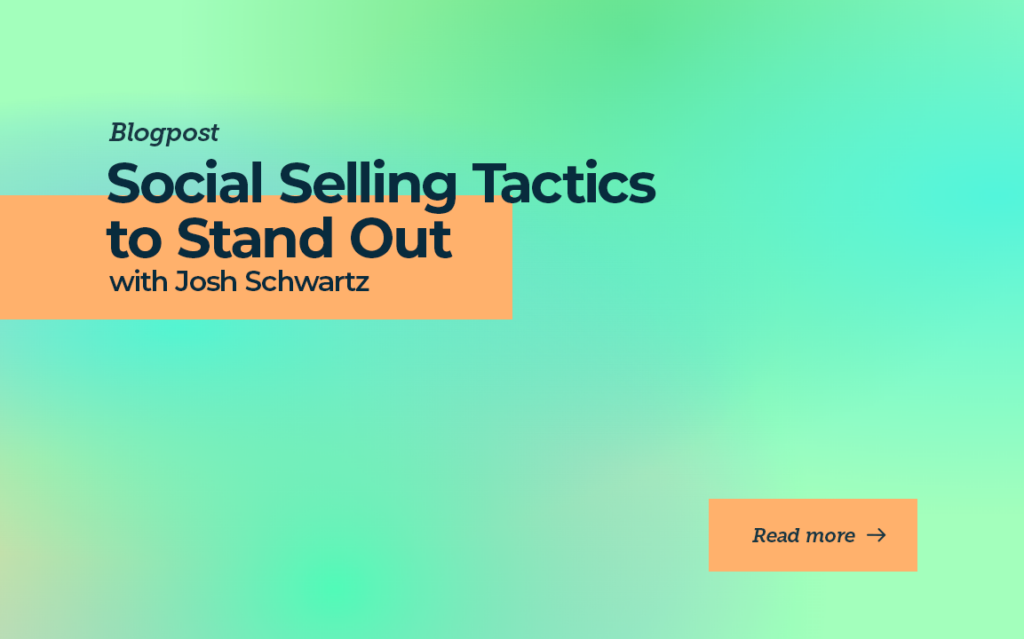Social Selling Tactics to Stand Out with Josh Schwartz

In today’s digital age, traditional methods of building rapport, such as face-to-face meetings, are no longer as prevalent. Instead, social selling tactics have become a powerful tool for salespeople to connect with prospects and build relationships online.
Josh Schwartz joined us on the Predictable Revenue Podcast to discuss the importance of building rapport with prospects and discuss effective social selling tactics to help sales professionals establish meaningful connections with potential customers.
The Importance of Building a Relationship
Reaching out to potential clients, partners, or even acquaintances can be intimidating. It’s understandable to feel the urge to copy and paste a template email and send it to everyone on your list. But as Josh points out, this approach can burn bridges and alienate your target market.
So, what should you do instead? The answer is simple: build a relationship.
Building a relationship with someone before asking for their time or business is crucial. It’s human nature to feel more comfortable and open to those we know and trust. By taking the time to research and personalize your outreach, you’re showing the other person that you value their time and are genuinely interested in what they do.
Personalization can take many forms, depending on the situation. It could be as simple as mentioning a mutual connection or commenting on something the person posted on social media. Or it could involve researching the person and their company more in-depth and tailoring your message accordingly. Whatever the case may be, the point is to show that you’re not just sending a generic email to anyone who will listen.
Building a relationship with the person you’re reaching out to also sets the stage for a more productive meeting. The other person will be likelier to engage with you and listen to what you have to say.
On the other hand, if you haven’t taken the time to build a relationship, you may find yourself struggling to make a connection, or even worse, the person may be just humoring you to get you off their back.
You’ll see a lot of people that take meetings just so that you go away, and that’s not the type of meeting you want…. Tell me what you can do, so you’ll stop bothering me.
While taking shortcuts when reaching out to others may be tempting, building a relationship first is ultimately more effective. Personalizing your outreach and getting to know the person will set you up for more productive meetings and potentially long-lasting business relationships.
So, next time you’re considering sending a template email, take a step back and consider how to personalize your message to make a stronger connection.
Stand Out as a Sales Representative
Setting yourself up for success and standing out from the crowd is essential.
According to Josh, one way to do this is by using LinkedIn Sales Navigator to follow your key accounts and personas and personally engage with them.
Simply scrolling through your feed and letting the algorithm pick for you is a huge mistake and a waste of time. Instead, make sure you have Sales Navigator set up correctly, follow the right people and accounts, and receive the right news delivered to you.
Avoid generic messages like “Congrats on the new role” or “Happy birthday.” While these messages may seem polite, they won’t help you break through and make a meaningful connection. Focus on finding unique and personalized ways to reach out to your prospects. This could include using tools like Sendoso, direct mail, or even social media platforms like Twitter.
However, it’s not just about using the right tools; it’s about using them effectively and in the correct order. If you’re new to the job, it can be overwhelming to know where to start. That’s where resources like books, webinars, and online courses come in handy.
These tools can teach you how to get meetings with everyone, use LinkedIn creatively, and use direct mail or other outreach strategies effectively.
How to Set Yourself Up to Catch Potentially Engaging Moments
Timing and relevance are crucial for targeting potential customers. No matter how great your messaging is, it won’t be as effective if irrelevant to your target audience.
One effective method for targeting is Josh’s triple tap methodology:
- Find a post from a prospect on LinkedIn.
- Engage with it (but don’t hit the standard-like button.)
- Read the content.
- Comment on the content piece, and share it.
- Write a personalized email about it.
- Send an email!
It begins by getting the right messages and data inside LinkedIn. You start by finding the most recent post at your target company and looking at what the person said. Then, instead of just liking it, use a different reaction like laughing, heart, or support to stand out from the crowd.
Next, read the article or post and use the information to craft a personalized message or email that ties your product or service with their persona and what they said. Timing is crucial here because you want to send the message or email quickly after the like or reaction to increase the likelihood of a response.
However, tying everything together in a single spot and making it work can be challenging. It requires a deep understanding of your personas, messaging, and creativity. It’s a skill that can’t be automated by an AI chatbot, making it essential for salespeople to have the ability to connect with customers creatively.
Targeting wins every day if you have somebody relevant to your product or service, and it’s essential to set yourself up to catch those moments. The triple tap methodology can help target potential customers, but it requires creativity, understanding of your personas, and messaging to make it work.
Learn more from Josh’s 4 tactics for social selling here.
Presenting Options: Finding the Right Approach
When it comes to presenting options, there isn’t necessarily a one-size-fits-all solution. Understanding the nuances of each approach can help you make a more informed decision when presenting options to prospects.
Josh mentions providing two options and letting the third option be the person’s choice. This common approach can be practical in situations where the person may feel overwhelmed by too many choices. The two options act as a starting point and give the person some direction, but the third option allows for personalization and autonomy.
On the other hand, this approach which involves asking if someone is interested in learning more is based on the idea that people are more likely to engage with something when they feel like they have a choice in the matter. Presenting the information in a non-threatening way and letting the person express their interest can lead to a more productive and positive conversation.
Ultimately, the best approach will depend on the situation and the person you present the options to. It’s important to consider factors such as the person’s preferences, the call-to-action, and the desired outcome. Being open to feedback and adapting your approach as necessary can also lead to more successful outcomes.

Qualifying the Prospect Without Being Pushy
One of the biggest hurdles is qualifying a prospect without coming across as pushy or salesy.
As the old saying goes, “You catch more flies with honey than vinegar,” and the same is true when it comes to lead generation. Instead of trying to sell someone right off the bat, it’s better to qualify them first and ask if they are the right person to talk to.
This approach shows respect for the prospect’s time and helps you navigate the organization more efficiently. If the person you’re speaking with isn’t the right fit, they may be able to connect you with someone who is. Plus, by not making assumptions about who you should be speaking with, you avoid potentially alienating a potential ally or advocate within the organization.
The key to making this approach work is to make it easy for the prospect to respond, even if the answer is “no.” Avoid bombarding them with a laundry list of requests or complicated call-to-actions that may turn them off. Instead, keep your message straightforward, and make it clear what you’re offering and why it’s relevant to them.
By focusing on qualification first and making it easy for prospects to respond, you can build stronger, more meaningful connections that lead to long-term success.
Using Twitter Lists to Book Meetings
Social media platforms like Twitter can be powerful tools for sales prospecting. However, finding the right people to connect with can be challenging with the abundance of content out there. This is where Twitter Lists come in.
Twitter Lists are a feature that allows users to create custom lists of Twitter accounts based on their interests or categories. For example, you can create a list of industry influencers, prospects, or customers. By creating a list of prospects, you can easily keep track of their tweets, engage with their content, and stay up to date on their activities.
But how can you use Twitter Lists to prospect effectively? Here are a few tips:
- Create targeted lists
When creating a list of prospects, be specific and targeted. Avoid creating a broad list of everyone in your industry and instead focus on a smaller group of individuals who are more likely to engage with your content or have a need for your product or service.
Josh’s approach is to create lists that actually make the prospect feel good when they notice they’ve been added, like a list that features the ‘best podcast hosts’ in a specific industry or the ‘top b2b influencers in America’.
- Add value to your prospects
Instead of just adding your prospects to a list and forgetting about them, engage with their content and add value to their Twitter experience. Retweet their tweets, reply to their posts, and share relevant industry news or articles with them.
- Send personalized messages
When you add someone to a Twitter list, they receive a notification. Use this opportunity to send a personalized message to introduce yourself and explain why you added them to your list. This can help start a conversation and build a relationship.
- Monitor your prospects’ activities
You can gain insights into their interests and needs by regularly monitoring your prospects’ tweets and engagement. This information can help you tailor your outreach and messaging to better resonate with them.
Conclusion
Social selling has emerged as a pivotal aspect of today’s sales landscape. It enables sales professionals to expand their reach, meaningfully engage with prospects, and cultivate lasting online relationships.
Remember, the essence of social selling lies not merely in product promotion but in forging authentic connections and offering real value to potential clients. This approach of rapport-building can significantly drive revenue and foster mutually beneficial relationships.
Whether you’re new to sales or refining your current tactics, embracing social selling can significantly elevate your relationship-building success.
Interested in Josh’s expert social selling strategies? Connect with him on LinkedIn.
Additionally, for a more comprehensive insight into integrating advanced sales methodologies and tools, consider booking a personalized demo call with Predictable Revenue. Our team is dedicated to guiding you through innovative strategies that can transform your sales process. Book your demo here.
NO TIME TO READ?
Listen On:



